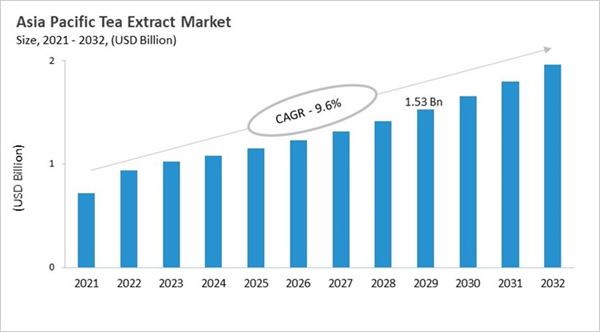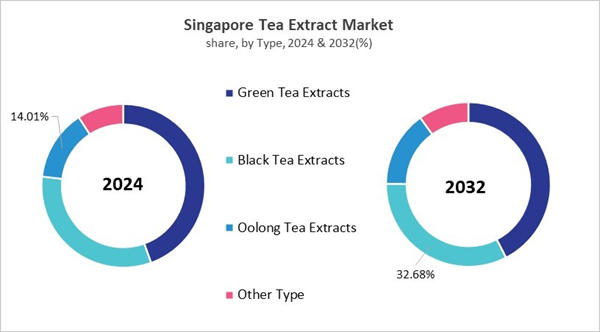The China market dominated the Asia Pacific Tea Extract Market by country in 2024, and is expected to continue to be a dominant market till 2032; thereby, achieving a market value of $578.5 million by 2032. The Japan market is registering a CAGR of 7.2% during 2025-2032. Additionally, the India market is expected to showcase a CAGR of 8.5% during 2025-2032. The China and Japan led the Asia Pacific Tea Extract Market by Country with a market share of 33.4% and 19.2% in 2024. The Singapore market is expected to witness a CAGR of 10.1% during throughout the forecast period.
From centuries-old tea cultivation customs, the Asia-Pacific tea extract market has developed into a contemporary, vibrant sector propelled by growing consumer demand for natural, useful ingredients. Utilizing the health advantages of substances like catechins, polyphenols, and antioxidants, tea extracts are now extensively used in food, drink, nutraceuticals, and cosmetic products. Strong agricultural bases in important producing nations like China, India, and Japan, as well as convenient product formats and growing international trade, are driving the market's expansion. The demand for ready-to-drink beverages, fortified snacks, and supplements enhanced with tea extracts has increased due to rising urbanization and shifting lifestyles.
To improve their market position, major industry players are implementing tactics like portfolio diversification, technological innovation in extraction processes, and vertical integration. In addition to facilitating international expansion, investments in clean-label products, sustainable operations, and organic certification are assisting businesses in meeting changing consumer and regulatory requirements. Multinational ingredient companies, local processors, and specialized manufacturers continue to compete fiercely on the basis of quality, product purity, technological prowess, and sustainability credentials. All things considered, the Asia-Pacific tea extract market is a well-balanced mix of innovation and tradition, propelled by a strong supply chain and a growing number of health-conscious consumers worldwide.
Category Outlook
Based on Category, the market is segmented into Conventional and Organic. With a compound annual growth rate (CAGR) of 6.8% over the projection period, the Conventional Market, dominate the Japan Tea Extract Market by Category in 2024 and would be a prominent market until 2032. The Organic market is expected to witness a CAGR of 7.9% during 2025-2032.Type Outlook
Based on Type, the market is segmented into Green Tea Extracts, Black Tea Extracts, Oolong Tea Extracts, and Other Type. Among various Singapore Tea Extract Market by Type; The Green Tea Extracts market achieved a market size of USD $22.1 Million in 2024 and is expected to grow at a CAGR of 9.4 % during the forecast period. The Black Tea Extracts market is predicted to experience a CAGR of 10.2% throughout the forecast period from (2025 - 2032).Application Outlook
Based on Application, the market is segmented into Food & Beverage, Pharmaceuticals & Dietary Supplements, Cosmetics & Personal Care, and Other Applications. The Food & Beverage market segment dominated the India Tea Extract Market by Application is expected to grow at a CAGR of 7.9 % during the forecast period thereby continuing its dominance until 2032. Also, The Cosmetics & Personal Care market is anticipated to grow as a CAGR of 9.1 % during the forecast period during 2025-2032.Country Outlook
Growing health consciousness, urban lifestyles, and the desire for functional beverages have led to a unique blending of the ancient tea heritage and contemporary consumer trends in the Chinese tea extract market. Thanks to China's robust tea production capabilities, green, black, and specialty tea extracts are being used more frequently in nutraceuticals, ready-to-drink beverages, and personal care products. Trends in the market include clean-label formulations, e-commerce growth, and high-quality, genuine extracts from areas like Yunnan and Fujian. Local manufacturers, global ingredient companies, and creative start-ups make up the competitive landscape. All of them prioritize product differentiation through quality, purity, and innovative applications to satisfy changing consumer demands.List of Key Companies Profiled
- Synthite Industries Ltd.
- MartinBauer
- Kemin Industries, Inc.
- Tata Consumer Products Limited (Tata Group)
- James Finlay Limited
- Archer Daniels Midland Company
- AVT Natural Products Ltd
- Indena S.p.A.
- Taiyo International (Taiyo Kagaku Corporation)
- Dohler GmbH
Market Report Segmentation
By Category
- Conventional
- Organic
By Form
- Powder
- Liquid
- Encapsulated
By Type
- Green Tea Extracts
- Black Tea Extracts
- Oolong Tea Extracts
- Other Type
By Application
- Food & Beverage
- Pharmaceuticals & Dietary Supplements
- Cosmetics & Personal Care
- Other Applications
By Technology
- Solvent Extraction
- Supercritical Fluid Extraction
- Ultrasound-Assisted Extraction
- Other Technology
By Country
- China
- Japan
- India
- South Korea
- Singapore
- Malaysia
- Rest of Asia Pacific
Table of Contents
Companies Mentioned
- Synthite Industries Ltd.
- MartinBauer
- Kemin Industries, Inc.
- Tata Consumer Products Limited (Tata Group)
- James Finlay Limited
- Archer Daniels Midland Company
- AVT Natural Products Ltd
- Indena S.p.A.
- Taiyo International (Taiyo Kagaku Corporation)
- Dohler GmbH










